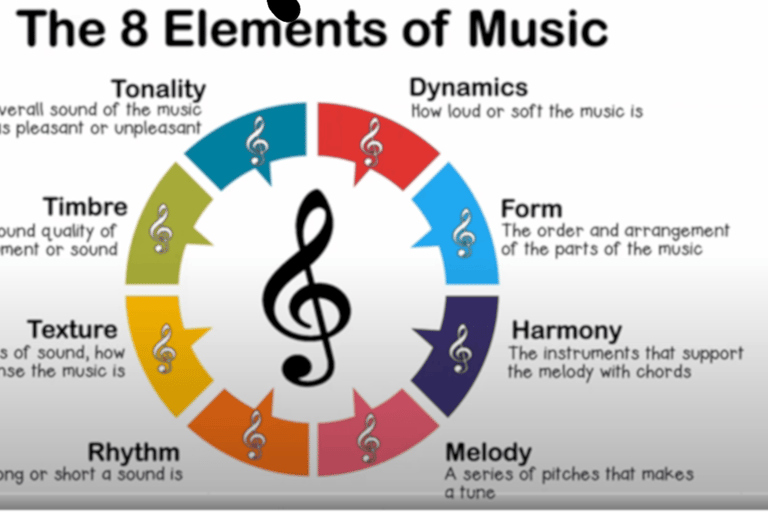Classic Rock Music Appreciation
(by the EARWORM)
Note: This Pictorial does not show on Mobile
A Song is created by a Recipe based on the 8 Elements… they all contribute to its overall appeal of it, but it is the Mix that is unique to a Musician and its Composer
Dynamics refers to the volume of a Track… it can vary from Loud to Soft and Soft to Loud. It is all based on the collaboration between the Performers and the Composer's interpretation the Track
Form/Structure refers to the Order and Arrangement of the parts of a Track including Intro, Verse, Chorus, Bridge, Solo, and In and Outro
Harmony is the Sound created when 2 or more Pitches are performed at the same time to form a Chord… in most CR Tracks, the Guitar is the main Instrument that supports the maim Melody performed by the Singer… other pitched instruments contribute and support the harmony’s melody and Chordal accompaniment
Melody is a series of Pitches that make a Tune that holds the Elements together… it determines the Harmony and Tonality of the piece. The main melody can be heard from an Instrument that has a unique Timbre or Tone’s Color/Quality… if a Melody is meant to be happy or sad, it can drive the Rhythm of the track and set the Tempo
Rhythm is the duration of how long/sustained or short a Sound is… its Tempo and the type of Time Signature used
Texture refers to the number of Instruments or Voices that contribute to the overall Density of the Track… it can be either Thin Sparse, Thick, or Dense. It defines the layers of Sounds, i.e., Monophonic, Homophonic, Heterophonic, or polyphonic
Timbre refers to the unique sound quality of an Instrument… for example, a Guitar with nylon strings is different from steel strings, It is like a Painting that uses Color to emphasize images whereas an Instrument paints unique Sounds defining the Quality of a Track… it describes the Role of an Instrument whether performing the Melody, Beat, Rhythmic accompaniment, Chordal harmonic
Tonality refers to the overall Sound (the package) of a Track… whether pleasant (Consonant) or unpleasant (Dissonant)?… or the Track is in a Major or Minor Key and it Modes (Modality).
************
The Concepts of Music
To further define Music by using Advance Music Theory Dynamics and Tempo…
By using Dynamic markings, Composers and Performers can shape the narrative and Expressive Elements of a Composition… and changes in Tempo can be used to create Dynamic contrasts, evoke emotions, and signal shifts in Mood or Energy to the listener. Together, Dynamics and Tempo work to shape the expressive, emotional, and structural aspects of a Track… that guides the Performer engaging the listener in a cohesive and compelling musical narrative.
Using gradual changes in Dynamics, such as Crescendos (louder) and Diminuendos (softer) to build Tension… allows for a Nuanced and Dynamic interpretation adding depth and interest
Composers can introduce changes in Tempo to create contrast and highlight different Sections… such as a sudden change to a slower Tempo can signal a shift to a more introspective passage… a faster Tempo can inject energy and excitement into an Audience
Combining changes can achieve heightened Contrast and Impact… where a sudden increase in both can create a climactic movement while a gradual decrease can lead to a Peaceful and Reflective conclusion
************
Music Appreciation… (How to know what you are hearing?)
Active Listening is the “Art and Craft” of identifying all the Sounds that you hear… to be able to identify and evaluate a Track's Artistic points, Technical merit, and Intellectual value. In other words, enjoy the experience by listening to, and enjoying the whole Track… that is the Goal of all Performers
Timbre is recognizing the difference in Sounds from one Track/Band to another… but first one has to learn to truly listen to the Beat, often the Drum, but melding with the other Sounds… from 50BPM to 220BPM.
Every listener will determine the Style of their preference based on the Tempo and the Pitch (Notes) referring to the number of times Sounds vibrate back and forth throughout one second… musical Notes are controlled and intentional as compared to the Sounds of Nature that are unpredictable
A sudden change to a slower Tempo can signal a flip in Mood or lessen one’s Energy… it can evoke feelings of Relaxation or Sadness that can lead to a more Subdued or Reflective atmosphere.
While a faster Tempo can inject Energy and Excitement or Urgency… or even a sense of Anticipation leading to the most pleasant Emotions… fast Tempo changes can capture a listener’s attention and maintain Engagement to a Track.
The concept of Mode refers to a collection of Pitches (Scales) that are Major and minor… to be sure; Musicians have created thousands of 5, 7, and 8-Note Scales. Different Scales arouse different Emotions from two Listeners side-by-side… it is a personal Trait.
Scales are Pitch Inventories from which derive Harmony (Notes sounded on top of one another in simultaneity… while Melody refers to Notes sounded one after another. Classic Rock is known for its catchy Melodies and memorable Hooks… they must deliver “Earworms” that make a Listener say, “I can’t get that Song out of my head” which mostly occurs when the Brain is relatively unoccupied.
Earworms are not planted but are part of what is called a natural “Cognitive Phenomenon” that repeats in a person’s Mind voluntarily… if you sing in the Shower, you know what I mean.
Note: One aspect of attempting to plant Earworms was in the late 50s with the Payola Scandal that put Alan Fried in jail in 1960


